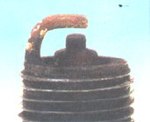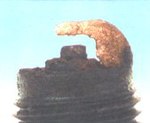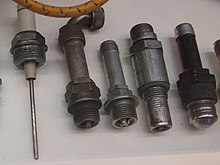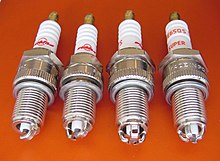spark plug
In Otto engines and when starting gas turbines and jet engines, a spark plug generates the spark between its electrodes that is necessary to ignite the fuel-air mixture .
history
The development of the spark plug is closely linked to magneto ignition. On the way from glow tube ignition to the age of low-voltage magneto ignition (1886–1902) with a nominal voltage of 400 to 500 volts to high-voltage magneto ignition (1902 to the present day), spark plugs have undergone constant development, including from mica to ceramic insulators. In 1878/79 Carl Benz developed a compressionless two-stroke engine and later a light four-stroke engine . Benz developed the belt shift as a clutch , the carburetor , a water cooler and a spark plug. Paul Winand received the German Imperial Patent 45161 in 1887 and a US patent on October 24, 1893 for an electrical ignition device (including spark plug) based on the principle of high-voltage magneto ignition. In 1895 Ludwig Rüb used a high-voltage magneto ignition on his motorcycle for the first time. In 1901, Gottlob Honold further developed the high-voltage magneto ignition in Robert Bosch's workshop for precision mechanics and electrical engineering in Stuttgart , and helped ignition, which was crucial for the construction of high-speed gasoline engines , to achieve an economic breakthrough.
Basics
The ignition voltage generated by the ignition coil and ignition interrupter (ignition contact - now known as an electronic ignition system) is transmitted to the spark plugs via the spark plug cables. There the ignition spark generated by the ignition voltage jumps between a ceramic-insulated center electrode and a ground electrode fixed to the fastening thread, thus starting the combustion process.
Since around 1989, some automobile manufacturers have switched to generating the ignition voltage directly on the plugs using electronics (so-called "single spark ignition coils"). On the one hand, this increases the system costs, since each plug requires its own electronics integrated into the spark plug connector, on the other hand, it means that no high-voltage cables have to be laid in the engine compartment, which considerably simplifies the construction of the engine (no more risk of flashovers, significantly less electromagnetic interference , improved reliability).
The spark plug should reach its self-cleaning temperature between 360 and 850 ° C as quickly as possible. Self-cleaning prevents a short circuit or shortening of the spark gap between the electrodes by burning off combustion residues. The length of the insulator foot surrounding the center electrode determines the thermal value of a spark plug. With a short insulator base, the heat can quickly be dissipated through the thread to the cooled cylinder head. Here one speaks of a "cold" candle with a low heat value. This is used for highly stressed engines.
Spark plugs with their heat values must be adapted to the respective engine. The above malfunction can occur if the spark plug is too “cold”. If, on the other hand, a “warm” spark plug is chosen, the electrodes will burn up too quickly.
Electronically controlled spark plugs are no longer subject to significant wear.
new technologies
Recently, sliding spark plugs are also increasingly used . Air sliding spark plugs used. These have several individual ground electrodes (usually 2 or 4) or a 360 ° electrode and a longer-lasting center electrode (depending on the choice of material and shape). In contrast to a conventional spark plug, the ignition spark glides over an insulator material - with the air sliding spark plug the ignition spark also jumps over a small air gap - always to the ground electrode, which is the closest to the center electrode. Due to the insulator, the spark gap is considerably larger than with normal candles. A longer spark resp. a larger spark surface and the spark gap that is exposed in contrast to a conventional spark plug have a considerable influence on the ignition process and can improve combustion.
Attempts are currently being made to ignite the gasoline-air mixture using a laser beam . This must be done through a quartz glass pane. However, the ongoing pollution of the glass causes problems.
Thread and seat shape
There are only standard sizes of spark plugs. These are used depending on the type and size of the motor. The spark plugs differ in length, diameter and pitch of the spark plug thread :
| thread | Key-width | use |
|---|---|---|
| M 8 × 1 | SW 13 | installed in small 4-stroke scooters; z. B. Honda NPS 50 Zoomer |
| M 10 × 1 | SW 16 | installed in older mopeds; z. B. Honda CY / CB / XR / XL 50 |
| M 12 × 1.25 | SW 18 | mostly on motorcycles; recently, increasingly also in cars |
| M 14 × 1.25 | SW 20.8 | on most car engines |
| M 14 × 1.25 | SW 16 | |
| M 16 × 1.25 | SW 16 | |
| M 18 × 1.5 | SW 20.8 | |
| M 18 × 1.5 | SW 25.4 | rarely with car engines, often with old two-stroke engines ; Standard on aircraft engines before 1930 |
In addition to different threads, there are also different seat shapes. The classic design has a flat seat with a sealing ring. In addition to this shape, candles with a conical seat are also used, which do not require a sealing ring.
execution
Some spark plugs contain a built-in Suppression resistance of approximately 5 kOhm. You can usually recognize these types by the letter R (e.g. from Bosch and NGK ) in the type designation.
This spark plug variant can easily be used in conjunction with spark plug caps with an integrated resistor (interference suppression spark plug caps). A weakening of the ignition spark through the series connection of the resistors is not to be feared. NGK writes: The use of NGK spark plug connectors with interference suppression resistors in connection with interference suppression NGK spark plugs offers optimal suppression of interference frequencies in all frequency ranges without negatively affecting the running behavior of the engine.
The spark plug connector is attached to the spark plug and thus establishes contact with the center electrode. There are plugs that require an SAE connection nut on the plug instead of the connection bolt (M 4 thread) . This nut can be unscrewed with pliers on almost all spark plugs if it is not needed. With new spark plugs, the nut is usually placed separately in the packaging, so that it has to be screwed on first if necessary.
Heat value
The heat value is specified as a number in the type code. This value stands for the maximum operating temperature that is set by the ability of the candle to absorb and dissipate heat from the combustion chamber. The heat supply to the spark plug in the combustion chamber depends on the type of engine.
The heat value is of elementary importance, as a minimum temperature of around 400 ° C must be reached as quickly as possible after the engine has started, so that the spark plug can "burn free" residues on the insulator, avoiding sooting and the associated misfiring to be avoided (free burn limit, "self-cleaning temperature" = 450 ° C). On the other hand, however, a maximum temperature of approx. 900 ° C (pre-ignition range) must not be exceeded at any point on the candle, as otherwise the engine tends to self-ignite, which would manifest itself in the engine knocking . This means that the heat value must always be adapted to the heat development in the engine's combustion chamber so that the correct operating temperature is set on the plug.
The key figures of the heat values vary from manufacturer to manufacturer. Bosch , BERU and Champion ( Federal-Mogul ) use high numbers for “hot” spark plugs, NGK and Denso, on the other hand, use low numbers; the key figures are therefore not transferable between manufacturers. For this reason, the manufacturers indicate the correct heat value for common motors in tables or on their websites. Changes to the combustion, such as through tuning measures (e.g. increase compression) or alternative fuels (e.g. LPG), also change the combustion temperature and thus the required heat value of the spark plug. Some manufacturers also provide this information.
A “cold” spark plug dissipates as much heat as possible via the insulator and the electrode. The ceramic insulator is shorter than that of a comparatively “hot” spark plug, which leads to lower heat absorption and greater heat dissipation via the plug thread. Composite electrodes further improve heat dissipation, for example with a nickel electrode with a copper core that conducts heat well. A “cold” spark plug therefore tends to belong to a powerful engine with a high level of heat input into the material of the spark plug. A “hot” spark plug reliably ensures that the burn-off temperature is reached and is found in engines with low loads. A longer insulator foot ensures that heat is absorbed into the candle with less heat dissipation through the candle thread.
Electrode design
There are numerous manufacturers of spark plugs who do not only supply versions with two electrodes. Today designs with three, four or even five electrodes are common. A special design are candles with a split electrode, which are offered under the brand name "Splitfire".
It is not the candle manufacturer who determines which version is to be used in the respective engine, but the engine manufacturer; The design of the electrode shape or design and the spark position (dimension from the end of the plug thread to the electrode tip) is determined when the motor is developed. In modern gasoline engines, the design has a significant influence on the running behavior, fuel consumption and emissions. Unauthorized changes to spark plugs can have a very negative effect on the engine. In the most harmless case, poor starting behavior, uneven running, lighting up of the engine control lamp (MIL) - but also major engine damage can be the result of choosing the wrong spark plug, especially in direct-injection engines, where precise ignition is particularly important.
Electrode gap
Modern transistor ignition systems deliver significantly higher voltages than the older interrupter ignitions. This allows longer spark gaps and thus larger electrode gaps. Since a larger electrode gap compared to a smaller one, due to the longer ignition spark, provides a larger attack surface for the gas mixture in the combustion chamber, much more efficient combustion is possible. Today, electrode gaps of 1 mm to 2 mm are no longer uncommon; values of 0.3 mm, 0.4 mm, 0.5 mm or 0.7 mm were common for ignition systems controlled by interrupter.
Since the center electrode becomes more and more distant from the ground electrode with increasing wear, the electrode spacing of a spark plug that is not yet too worn can be corrected by slightly bending the ground electrode. This is particularly recommended for single-cylinder, simple engines (mopeds, mopeds or mopeds as well as boat engines, etc.). In order to find the correct distance, you should measure with a feeler gauge or use a spark plug gauge .
Electrode material
With standard spark plugs, nickel or temperature-resistant iron-nickel-chromium alloys are used as the electrode material - with a copper core for better heat dissipation. For higher loads, platinum, silver, iridium or a nickel- yttrium alloy are used, which are also applied to the base electrode. This enables significantly longer service lives (longer replacement intervals). While passenger car engines were still changed at intervals of 10,000 to 15,000 km around 1980, modern candles (since around 2010) last up to 100,000 km. Inconel has proven itself in extreme thermal stress . This material is also used in exhaust gas turbochargers (turbine wheel).
Isolator material
The insulator is made of aluminum oxide . This ceramic is very brittle and a spark plug must be handled with care. A dropped spark plug - even if it looks intact - should no longer be used. Even the smallest bumps can cause cracks, which manifest themselves in malfunctions. The heat dissipation can be impaired, glow ignitions occur. Fragments of the insulator in the combustion chamber damage essential components of the engine and even damage the engine .
The spark plug picture
If a spark plug has been used in an engine for several hours of operation, you can use the so-called "candle image" or "candle face" (the appearance of the spark plug parts in the combustion chamber that has changed due to combustion) to determine whether the engine is working correctly. This is still possible today without restrictions, although workshops now prefer to use various measuring devices to detect faults in engines.
| Spark plug picture | Possible causes and consequences | Possible remedy |
|---|---|---|

|
Fawn-brown spark plug: The engine is working properly, the mixture composition is correct, the heat value of the spark plug is correct. |
No action is required. However, the spark plug in the photo on the left should be changed soon. You can see the wear on the rounded edges of the center electrode. |

|
Burned out spark plug: aggressive fuel and oil additives, combustion residues in the combustion chamber, poor fuel quality, defective valves or ignition distributors . Loss of power followed by a total failure of the engine. |
Check possible polluters, different fuel. |

|
Center electrode burned down: thermal overload from glow ignition, plug too hot, residues in the combustion chamber, ignition timing too early, defective valves or ignition distributors, poor fuel quality. |
Replace spark plug, check ignition timing, change fuel if necessary. |

|
Glazed spark plug: additives in oil and gasoline form ash-like deposits. The deposits cause misfiring at higher loads. |
Adjust engine, use branded spark plugs. |

|
Mechanically damaged spark plug: In the event of engine damage , metal chips can deposit on the spark plug or destroy it. Or a spark plug that was too long was installed. |
The spark plug should be replaced. If the damage is repeated, there is a mechanical defect in the motor. |

|
Spark plug charred / sooty: Spark plug could be too cold during operation (change heat value), fuel mixture is too rich, mainly used on short journeys, choke pulled too long (automatic starter adjusted) or air filter dirty. |
If the heat value of the spark plug is suitable, adjust the mixture composition (adjust carburetor or injection, check automatic starter if necessary) |

|
Spark plug encrusted: Components of the oil can form residues that are deposited on the spark plug. |
If necessary change the type of oil or check the engine setting. With 4-stroke engines: oil overfilling and / or high oil consumption due to worn engine components, faulty engine ventilation. Check piston rings, valve stem seals, engine ventilation. The candle has to be renewed as these deposits cannot be completely removed. |

|
Worn spark plug: aggressive fuel and oil additives, unfavorable flow influences in the combustion chamber, deposits and poor fuel quality. The consequences are misfiring, especially when accelerating and poor starting behavior. |
Check the cause, change the type of fuel. |

|
Oily spark plug: Too much oil in the combustion chamber, piston rings leaking, oil level too high, spark plug leaking (loose, defective) In two-stroke engines : Too much oil in the fuel due to the incorrect oil / fuel mixture ratio |
Tighten spark plugs, overhaul engine For two-stroke engines: Check the oil / fuel ratio or, in the case of separate lubrication, check the setting of the oil pump |

|
Spark plug melted or white: thermal overload. Glow ignition due to a plug that is too hot (change heat value) or the fuel mixture is too lean, engine tends to knock |
If the heat value of the spark plug is suitable, adjust the mixture composition (adjust carburetor or injection). Check the octane number of the fuel if necessary. |

|
Spark plug bridged: Long-term operation with a cold engine / low load; Mixture too rich. With leaded fuels, the spark plug can be bridged by lead deposits. |
Remove the (soot) bridge using wood chips, warm up the engine and operate it with a higher load. Avoid cleaning with wire brushes of any kind, as metal abrasion on the insulator base leads to malfunctions again. |
Spark plug with integrated sensor
Measurement of the combustion pressure
Classic indexing technology requires the pressure in the cylinder to be measured. With the help of the pressure measurement, conclusions can be drawn about the combustion processes and furthermore about the efficiency of the engine. Piezoelectric pressure sensors, which are normally screwed into an additional mounting hole in the cylinder head, are used for this pressure measurement . Since this requires mechanical processing, a solution was sought to integrate such sensors in the spark plug. Suppliers such as Bosch, AVL, Kistler or Piezocryst offer different solutions and are named here as the most important market competitors.
Optical indicating measurement technology
In order to use optical measurement technology in combustion measurement technology, AVL developed spark plugs with integrated optical light guides for the first time, which allow a view into the combustion chamber. Combustion processes can thus be optically recorded and studied.
Measurement of the ion current
During combustion, the gas in the combustion chamber contains a high proportion of ions due to its high temperature and is therefore weakly conductive. In engine research, sensor spark plugs are used to draw conclusions about the combustion via the ion current. There are also sensor spark plugs with an integrated pressure gauge to obtain information on the combustion process. The integrated ion current measurement cannot be used during the ignition spark.
Daihatsu uses ion current measurement in the K3 engine (which was built into the YRV, Sirion and Copen), as well as in the EJ-VE engine built into the Cuore L251.
See also
literature
- Richard van Basshuysen , Fred Schäfer: Handbook internal combustion engine. Basics, components, systems, perspectives. 3rd completely revised and expanded edition. Friedrich Vieweg & Sohn Verlag / GWV Fachverlage GmbH, Wiesbaden 2005, ISBN 3-528-23933-6
- Horst Bauer (Hrsg.): Kraftfahrtechnisches Taschenbuch. Published by Robert Bosch GmbH. 25th revised and expanded edition. Friedr. Vieweg & Sohn Verlag, Wiesbaden 2003, ISBN 3-528-23876-3 .
- Max Bohner, Richard Fischer, Rolf Gscheidle: Expertise in automotive technology. 27th revised edition. Verlag Europa-Lehrmittel, Haan-Gruiten 2001, ISBN 3-8085-2067-1
- Robert Bosch GmbH (ed.): Otto engine management. 3rd revised and expanded edition. Vieweg + Teubner, Wiesbaden 2005, ISBN 3-8348-0037-6
- Peter Gerigk, Detlev Bruhn, Dietmar Danner: Automotive engineering. 3rd edition, 4th printing. Westermann Schulbuchverlag GmbH, Braunschweig 2000, ISBN 3-14-221500-X
- Jan Drummans: The car and its technology. Motorbuch-Verlag, Stuttgart 1992, ISBN 3-613-01288-X
Web links
- Spark plug customer. Task, structure, requirements. In: bosch.com
- E-learning from NGK Spark Plug Europe. Interactive course on spark plugs, including animations etc. In: ngk-elearning.de (Flash plug-in required)
- Spark plugs. Spark plug technologies and requirements. In: ngk.de
- Spark plug basics. Structure, installation position, ignition spark distribution. In: ngk.de
- How the spark plug works. In: oldtimers-im-fokus.ch
- Working instructions ignition oscilloscope. Detailed observation of the ignition process from oscillograms. In: biat.uni-flensburg.de
- Everything about spark plugs. In: kfztech.de
Individual evidence
- ↑ Tim Aublach: The great sports car lexicon. ( limited preview in Google Book search).
- ↑ U.S. Patent 507516
- ↑ Hans-Joachim Mai: Evolution in small steps. In: Christian Bartsch (Ed.): A century of motorcycle technology. VDI Verlag, 1987, ISBN 3-18-400757-X , p. 268.
- ↑ http://www.saabhistory.com/2008/06/12/saab-direct-ignition-saab-innovation/
- ↑ NGK spark plug connector. NGK website. Retrieved June 10, 2010
- ↑ Spark plug part 2, automotive technology
- ↑ Bosch homepage
- ↑ Special adapter from AVL
- ↑ Kistler website
- ↑ Pressure sensors from PIEZOCRYST
- ↑ VisioKnock from AVL





